Unlocking the Stories Behind the Rock Sculptures of Kongwang Mountain: A Cultural Odyssey
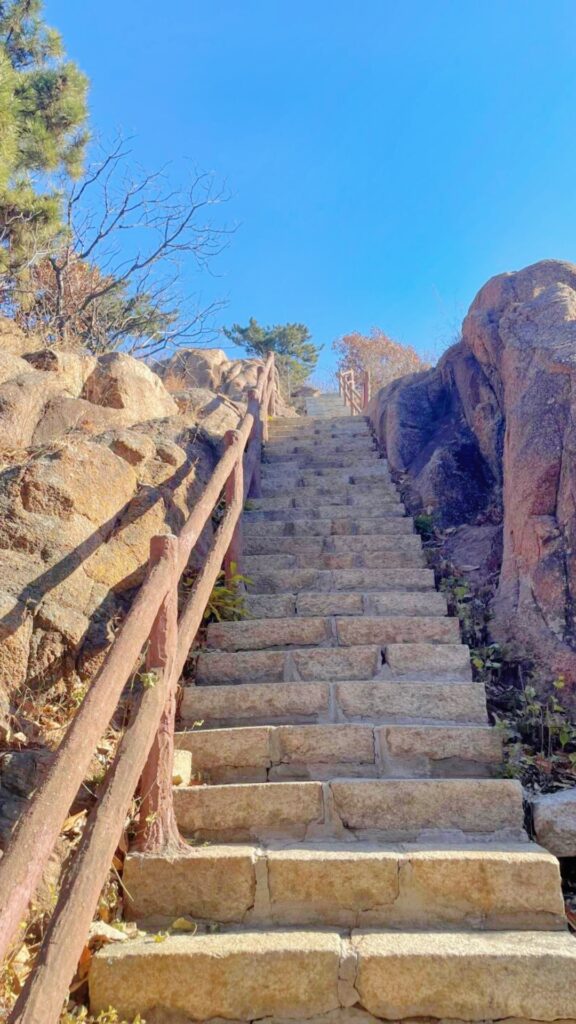
An Essential Guide to Visiting Rock Sculptures Of Kongwang Mountain
Nestled in the scenic embrace of Jiangsu Province, the Rock Sculptures of Kongwang Mountain stand as a testament to China’s rich cultural tapestry. What makes these cliff carvings truly unique is not just their age—dating back to the late Eastern Han Dynasty in 170 AD—but the way they challenge conventional narratives about the spread of Buddhism in China. Over a hundred intricately carved figures, depicting both Buddhist narratives and secular life, adorn the ochre-yellow cliffs, captivating visitors with their lifelike expressions and dynamic poses.
This guide invites you on a journey to explore these remarkable cliff carvings, offering insights into their historical significance, artistic techniques, and the surrounding natural beauty of Kongwang Mountain. You will discover not only the must-see sculptures but also practical tips for planning your visit. From the best times to go, how to navigate the area, and nearby attractions to enhance your experience, this guide ensures that your exploration of the Rock Sculptures is as enriching as the art itself. Prepare to be inspired by a blend of history, spirituality, and stunning landscapes as you uncover the secrets of Kongwang Mountain.
In This Guide
- An Essential Guide to Visiting Rock Sculptures Of Kongwang Mountain
- The Rich History and Legends of Rock Sculptures Of Kongwang Mountain
- Main Highlights: What You Absolutely Can’t Miss
- Planning Your Visit: A Practical Guide
- Tickets: Prices, Booking, and Tips
- How to Get There: A Complete Transportation Guide
- Local Cuisine and Accommodation Nearby
- Frequently Asked Questions
- Final Thoughts on Your Trip
The Rich History and Legends of Rock Sculptures Of Kongwang Mountain
An Ancient Legacy Carved in Stone
The Rock Sculptures of Kongwang Mountain, or Kongwang Shan, stand as a testament to the region’s rich cultural and artistic heritage. These cliff carvings, located in Lianyungang City, Jiangsu Province, date back to the late Eastern Han Dynasty around 170 AD, making them some of the earliest examples of Buddhist art in China. Their profound historical significance is intertwined with the very essence of the mountain, which has been a site of pilgrimage and reverence for centuries.
The Birth of a Masterpiece
The creation of these sculptures is believed to have coincided with a time of great spiritual development in China. As Buddhism began to spread from the west, artists and artisans sought to depict the teachings and stories of the religion in ways that resonated with local beliefs. The cliff carvings at Kongwang Mountain reflect a harmonious blend of Buddhist narratives and Taoist legends. This artistic endeavor culminated in the intricate carvings that adorn the ochre-yellow cliffs, where over 100 figures—ranging from towering statues to delicate engravings—tell stories that span both the divine and the earthly.
A Symbol of Spiritual Transformation
Among the most celebrated scenes is the “Nirvana Picture,” which poignantly illustrates the moment Sakyamuni, the historical Buddha, transcended to Nirvana. The expressions captured on the disciples’ faces—some filled with sorrow, others with despair—bring to life the emotional weight of this spiritual transition. This particular carving exemplifies the artists’ mastery in conveying deep human emotions through stone, a skill that has captivated visitors for centuries.
The Legends of Kongwang Mountain
Kongwang Mountain itself is steeped in legends that enhance the allure of its rock sculptures. One popular tale recounts that Confucius once climbed the mountain to gaze upon the sea, inspired by the beauty of nature and the mysteries it holds. This connection to Confucian philosophy adds an additional layer of significance to the site, as it symbolizes the interplay between nature, spirituality, and human reflection.
Another legend speaks of the mountain as a sacred portal where deities would descend to impart wisdom to the people. This belief has drawn countless pilgrims to the area, seeking enlightenment and blessings. The rock sculptures, therefore, not only represent artistic achievements but also serve as a bridge connecting the mortal realm with celestial beings.
Preservation of a Cultural Treasure
Despite enduring centuries of natural erosion and the passage of time, the rock carvings of Kongwang Mountain remain remarkably well-preserved. Experts attribute this longevity to the cliff’s protective overhangs and the resilient nature of the local stone. The sculptures have been hailed as a national treasure, challenging traditional narratives regarding the spread of Buddhism in China and providing scholars with invaluable insights into early Chinese art and religious practices.
Conclusion: A Journey Through Time
Exploring the Rock Sculptures of Kongwang Mountain is not merely a visual journey; it is an invitation to step into a narrative that spans over a millennium. Each figure carved into the stone tells a story of devotion, artistry, and cultural exchange that continues to resonate with visitors today. As you stand before these ancient masterpieces, you are reminded that history is not just something we study; it is something we experience, living on through the stories etched into the very fabric of the mountain.
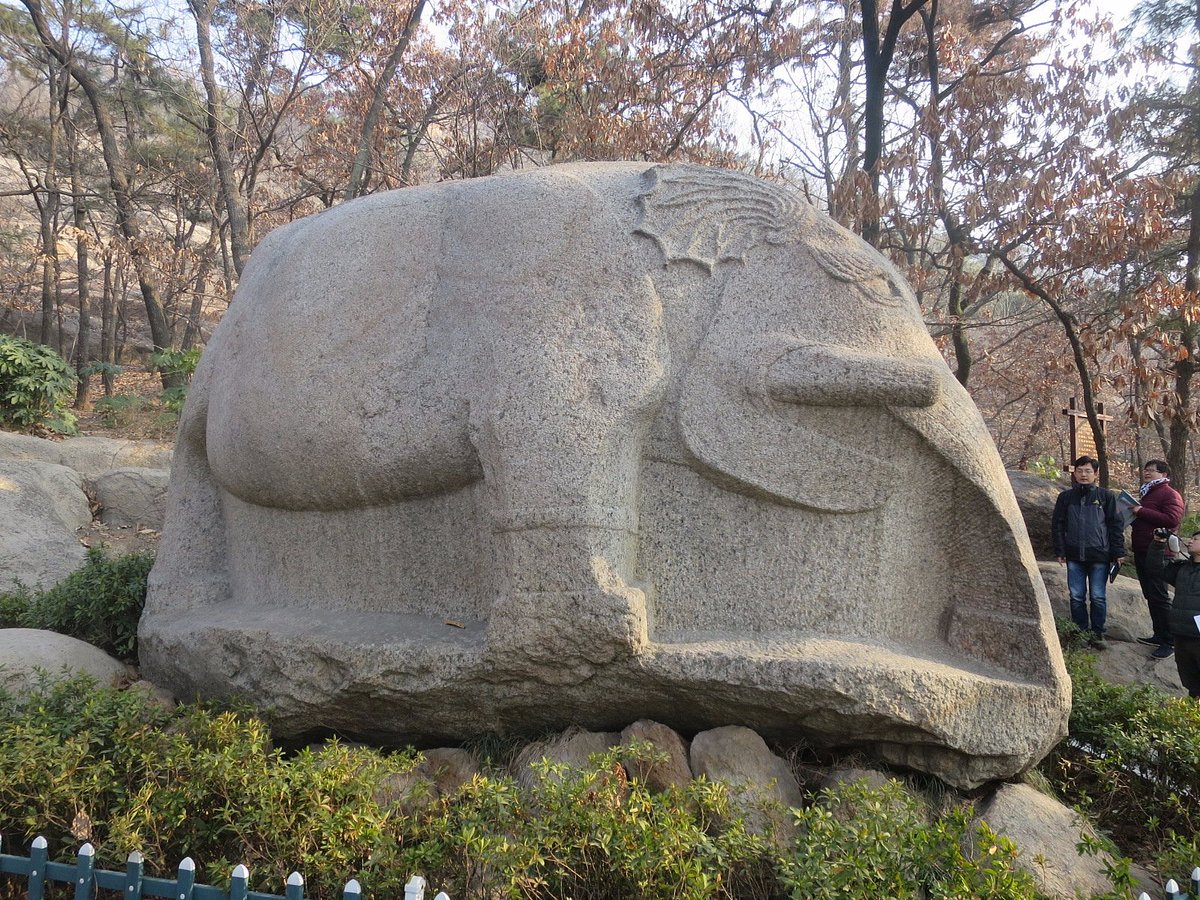
Rock Sculptures Of Kongwang Mountain.
Main Highlights: What You Absolutely Can’t Miss
1. The Majestic Cliff Carvings
As you approach the ochre-yellow cliffs of Kongwang Mountain, prepare to be awestruck by the intricate rock carvings that depict over 100 figures in various poses—standing, sitting, and even lying down. These sculptures, dating back to the late Eastern Han Dynasty (around 170 AD), illustrate scenes from both Buddhist and Taoist legends. Walking along the 17-meter-long, 8-meter-high cliff face, you’ll find yourself captivated by the lifelike expressions and dynamic forms of the figures, which have withstood the test of time.
Practical Tip: Bring a camera with a zoom lens to capture the details of these ancient artworks, and consider visiting early in the morning to avoid crowds and enjoy the serene atmosphere.
2. The Nirvana Scene
Among the many carvings, the “Nirvana Picture” stands out as a poignant representation of the Buddhist narrative. This powerful scene depicts the sorrowful reactions of Sakyamuni’s disciples as he departs for paradise, capturing a range of emotions from grief to despair. The intricate details in the expressions and postures of the figures make it a must-see for those interested in Buddhist art.
Practical Tip: Take a moment to sit nearby and reflect on the scene; it provides a unique opportunity to connect with the spiritual essence of the site.
3. The Han Dynasty Banquet Picture
Another highlight is the mesmerizing “Han Dynasty Banquet Picture,” which showcases the rich cultural heritage of the era. This carving portrays a grand feast, complete with figures engaged in various activities, from dining to entertainment. The craftsmanship highlights the artistic techniques of intaglio and bas-relief, showcasing the skill of ancient artisans.
Practical Tip: Use your smartphone to record a short video of the carving while providing commentary; it’s a great way to document your experience and share insights with fellow travelers.
4. The Buddha Statues
Don’t miss the impressive Buddha statues intricately carved into the cliff. These sculptures not only represent the historical significance of Buddhism in the region but also demonstrate the unique Han carving techniques. The diverse representations of the Buddha, Bodhisattvas, and Arhats showcase the evolution of religious art in China.
Practical Tip: Join a guided tour if available; knowledgeable guides can offer valuable insights into the stories behind these statues and their significance in Buddhist tradition.
5. The Scenic Surroundings
Beyond the cliff carvings, the stunning natural landscape of Kongwang Mountain enhances your visit. The picturesque views of the surrounding mountains and sea create a breathtaking backdrop. Take a leisurely hike around the area to fully immerse yourself in the beauty of this historic site.
Practical Tip: Wear comfortable shoes for hiking, and don’t forget to pack water and snacks. The trails can take you to less-explored areas where you can enjoy solitude and stunning vistas.
6. Longdong Temple
While exploring Kongwang Mountain, make sure to visit Longdong Temple, located nearby. This serene temple complex complements the cultural richness of the cliff carvings with its tranquil atmosphere and exquisite architecture. Here, you can gain deeper insights into the spiritual practices associated with the area.
Practical Tip: Plan your visit to coincide with a local ceremony or prayer session; it’s a wonderful way to witness the living traditions of Buddhism in the region.
7. Sunset Viewing Point
For a magical end to your day, head to a designated sunset viewing point on the mountain. Watching the sun dip below the horizon, casting golden hues over the cliff carvings, is an unforgettable experience. The combination of natural beauty and ancient artistry creates a moment of tranquility that resonates long after you leave.
Practical Tip: Arrive at least 30 minutes before sunset to secure a good spot and enjoy the gradual change in light. Bring a light jacket, as it can get chilly once the sun sets.
Exploring the Rock Sculptures of Kongwang Mountain offers a unique blend of history, art, and nature. Each spot on this journey reveals layers of cultural significance that will enrich your travel experience in this remarkable part of China.

Rock Sculptures Of Kongwang Mountain.
Planning Your Visit: A Practical Guide
Best Time to Visit
The Rock Sculptures of Kongwang Mountain can be enjoyed year-round, but the most favorable time to visit is during the spring (April to June) and autumn (September to November). During these seasons, the weather is mild, allowing for comfortable exploration and stunning views of the surrounding landscape. Additionally, the vibrant colors of blooming flowers in spring and the rich hues of autumn foliage add an extra layer of beauty to your visit.
Recommended Itinerary
For a fulfilling experience, allocate approximately 3-4 hours to visit the Rock Sculptures, along with other nearby attractions. Here’s a suggested itinerary:
- Morning (9:00 AM – 12:00 PM):
- Start your day early at Kongwang Mountain. Begin with a hike to the cliff carvings, taking time to appreciate the intricate details of the sculptures.
-
Spend about 30 minutes to 1 hour exploring the carvings and capturing their beauty.
-
Lunch (12:00 PM – 1:00 PM):
-
Enjoy a local meal at a nearby restaurant. Look for dishes that feature regional flavors, such as fresh seafood or local vegetables.
-
Afternoon (1:00 PM – 3:00 PM):
- After lunch, explore other nearby attractions such as Longdong Temple or Shipeng Mountain, both of which offer rich cultural experiences and breathtaking views.
Photography Tips
- Golden Hour: The best time for photography is during the golden hour, just after sunrise or before sunset. The warm light enhances the textures of the rock carvings.
- Wide-Angle Lens: Consider using a wide-angle lens to capture the vastness of the cliffs and the intricate details of the sculptures.
- Close-Ups: Get up close to the carvings to highlight their expressions and unique features. Focus on the various poses and emotions depicted in the sculptures.
- Avoid Crowds: Visit during weekdays or early in the morning to avoid the crowds and achieve a more serene atmosphere for your photos.
What to Wear
- Comfortable Footwear: Since exploring Kongwang Mountain involves walking and possibly hiking, wear sturdy shoes or hiking boots for comfort.
- Light Layers: Dress in layers to accommodate changing temperatures throughout the day. A light jacket or sweater is advisable, especially in the cooler months.
- Sun Protection: Don’t forget to wear sunscreen and a hat, as you may be exposed to the sun while walking around.
Insider Tips
-
Free Entry: Enjoy the fact that entry to the Rock Sculptures of Kongwang Mountain is free. This is an excellent opportunity to explore without the pressure of ticket costs.
-
Cultural Context: Before your visit, take some time to read about the historical and cultural significance of the sculptures. Understanding the stories behind the carvings will enhance your experience.
-
Local Guides: If you’re interested in a deeper understanding of the carvings and their history, consider hiring a local guide. They can provide insights that enrich your visit.
-
Nearby Attractions: Don’t miss out on other attractions in the area. The nearby Longdong Temple and scenic trails offer additional opportunities for exploration.
-
Stay Hydrated: Bring plenty of water, especially if you plan to hike. Staying hydrated is essential for enjoying your visit fully.
By planning your visit thoughtfully, you’ll be able to appreciate the magnificent Rock Sculptures of Kongwang Mountain and the beauty of their surroundings to the fullest. Enjoy your journey through history and art!
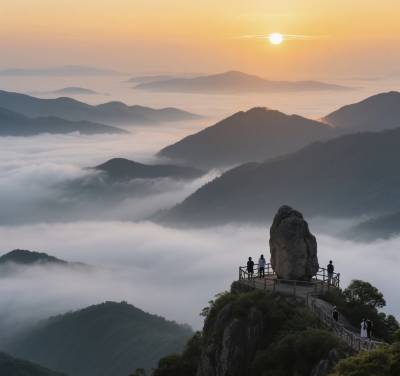
Rock Sculptures Of Kongwang Mountain.
Tickets: Prices, Booking, and Tips
When planning your visit to the stunning Rock Sculptures of Kongwang Mountain, it’s important to be aware of the ticketing details. Below is a comprehensive overview of ticket types, prices, and what’s included, ensuring you have all the information necessary for a hassle-free experience.
| Ticket Type | Price (CNY) | Includes |
|---|---|---|
| Adult Admission | Free | Access to the Rock Sculptures and surrounding scenic area |
| Child Admission | Free | Access to the Rock Sculptures and surrounding scenic area |
| Group Tour Ticket | Varies | Guided tour of the Rock Sculptures and additional attractions based on the tour package |
Booking Information
Admission to the Rock Sculptures of Kongwang Mountain is free, allowing visitors to explore this remarkable site without the burden of ticket costs. However, if you plan to join a guided group tour for a more immersive experience, it is highly recommended to book in advance.
How to Book:
-
Online Reservations: Use reputable travel websites or apps like Trip.com to reserve your spot on group tours. This allows you to secure your place and often provides access to exclusive promotions.
-
Local Tour Operators: Upon arrival in Lianyungang City, you can also check with local tour operators for availability of guided tours that include the Rock Sculptures.
-
Advance Booking: Due to the popularity of the Kongwang Mountain area, especially during peak tourism seasons, booking in advance is crucial. This ensures you won’t miss out on the opportunity to experience the rich history and artistry of the cliff carvings.
Tips for Your Visit
- Plan Your Visit: Allocate around 20-30 minutes to fully appreciate the cliff carvings, although you may want to spend longer if you’re keen on photography or taking in the scenic surroundings.
- Best Time to Visit: Early morning or late afternoon can provide the best light for photographs and a more peaceful atmosphere.
- Combine Attractions: Consider visiting nearby attractions such as Longdong Nunnery and Shipeng Mountain to enrich your experience in this culturally vibrant region.
By keeping these details in mind and planning ahead, you will ensure a memorable visit to one of China’s hidden cultural gems. Enjoy your journey into history at the Rock Sculptures of Kongwang Mountain!
How to Get There: A Complete Transportation Guide
Accessing the Enigmatic Rock Sculptures of Kongwang Mountain
The Rock Sculptures of Kongwang Mountain, nestled in the scenic Haizhou District of Lianyungang City, Jiangsu Province, are an unmissable attraction for history buffs and nature lovers alike. This comprehensive guide will help you navigate your way to this remarkable site, ensuring a smooth journey from major urban centers and around the scenic area.
From the Nearest Major City
Traveling from Lianyungang City
If you’re already in Lianyungang, you have several options to reach Kongwang Mountain:
- By Bus:
- Frequency: Buses to the Kongwang Mountain Scenic Area depart regularly from Lianyungang’s main bus station.
- Duration: The journey takes about 30-45 minutes.
-
Cost: Expect to pay around CNY 10-20 (approximately USD 1.50-3).
-
By Taxi or Ride-Hailing Service:
- Duration: A taxi ride will take about 20-30 minutes, depending on traffic.
- Cost: The fare will range from CNY 50-80 (around USD 7-12). Using apps like Didi Chuxing can be more convenient and affordable.
Traveling from Nanjing
If you’re coming from Nanjing, the capital of Jiangsu Province, here’s how to get there:
- By Train:
- Departure Station: Nanjing Railway Station.
- Duration: Take a high-speed train to Lianyungang, which takes about 2-2.5 hours.
-
Cost: Ticket prices range from CNY 100-250 (approximately USD 15-38) depending on the class.
-
From Lianyungang: Follow the aforementioned bus or taxi options to reach Kongwang Mountain.
Getting Around the Scenic Area
Once you arrive at the Kongwang Mountain Scenic Area, exploring the rock sculptures and surrounding attractions is manageable and enjoyable.
-
On Foot: The scenic area is designed for walking, with well-maintained paths leading you to the cliff carvings. A leisurely stroll around the area can take about 20-30 minutes to see the key features, including the impressive cliff carvings and various temples.
-
Local Transport Options:
- While the area is primarily pedestrian-friendly, you may find local rickshaws or electric carts available for hire, especially if you’re traveling with a group or prefer not to walk.
Tips for a Smooth Journey
-
Opening Hours: The Cliff Carvings at Kongwang Mountain are open year-round, 24/7, making it a convenient stop at any time.
-
Free Entry: There is no admission fee, allowing you to enjoy the art and history without any cost barrier.
-
Plan Ahead: If you’re visiting during weekends or holidays, consider arriving early to avoid crowds.
Conclusion
Visiting the Rock Sculptures of Kongwang Mountain is not just a journey to witness ancient artistry but also an exploration of the stunning natural landscapes of Jiangsu Province. With this transportation guide, you can confidently plan your visit and immerse yourself in the rich cultural tapestry of this extraordinary site. Safe travels!
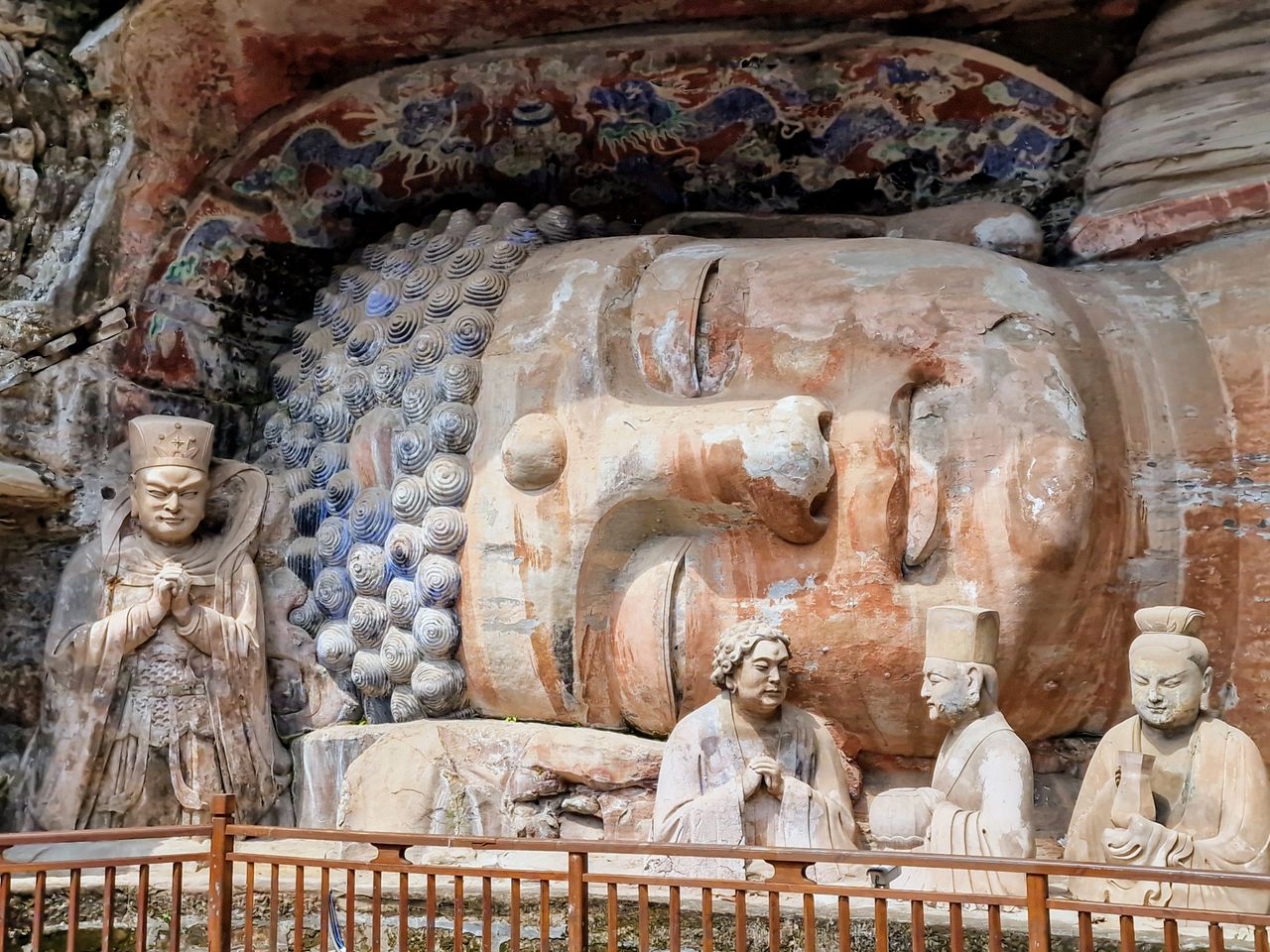
Rock Sculptures Of Kongwang Mountain.
Local Cuisine and Accommodation Nearby
Nestled in the scenic beauty of Lianyungang, the Rock Sculptures of Kongwang Mountain (孔望山摩崖造像) not only offer a glimpse into ancient artistry but also provide an opportunity to indulge in the local cuisine and find comfortable accommodations nearby. Here’s a guide to savor the flavors and rest your head after a day of exploration.
Culinary Delights to Savor
-
Lianyungang Seafood
Being a coastal city, Lianyungang boasts an abundance of fresh seafood. One must-try dish is the Steamed Yellow Croaker. This flavorful fish is typically seasoned with ginger and scallions, then steamed to perfection, allowing its natural sweetness to shine through. Served with a drizzle of soy sauce, it’s a true taste of the sea. -
Jiangsu-style Noodles
Dive into a bowl of Lianyungang Fried Noodles. These stir-fried noodles are tossed with an assortment of vegetables, succulent shrimp, and sometimes a hint of chili for a mild kick. It’s a hearty dish that perfectly encapsulates the local palate, blending textures and tastes harmoniously. -
Tangbao (Soup Dumplings)
Don’t miss the chance to indulge in Tangbao, delicate dumplings filled with hot broth and minced pork. These dumplings are a delightful culinary experience as you take a bite and savor the burst of flavorful broth inside. They are best enjoyed with a drizzle of vinegar and a sprinkle of ginger. -
Braised Bamboo Shoots
A seasonal delicacy, Braised Bamboo Shoots are often served as a side dish or a light main. Cooked slowly with soy sauce, sugar, and spices, they offer a delightful crunch and a subtle sweetness that complements richer dishes beautifully.
Accommodation Options Nearby
Luxury: Liandao Whale Shark Tent Hotel
For an unforgettable experience, consider staying at the Liandao Whale Shark Tent Hotel. This unique accommodation features eco-friendly tented lodgings that provide stunning views of the ocean and nearby mountains. The ambiance is serene, perfect for unwinding after a day of sightseeing, and the hotel offers various amenities, including an on-site restaurant serving fresh seafood.
Boutique: Huaguoshan Cliff Homestay
If you prefer a more personalized experience, the Huaguoshan Cliff Homestay is an excellent choice. Nestled amid lush greenery, this charming homestay boasts cozy rooms with stunning views of Yunu Peak. The owners often share local stories and insights, making your stay feel like a part of the community.
Budget: Haizhou Ancient City Ming Dynasty Granary Reconstruction Inn
For travelers on a budget, the Haizhou Ancient City Ming Dynasty Granary Reconstruction Inn offers affordable yet comfortable accommodations. With a unique design that reflects traditional architecture, this inn provides a glimpse into the region’s rich history while ensuring a restful night’s sleep. Plus, it’s conveniently located near local attractions, making it easy to explore the area.
Whether you’re feasting on delectable local dishes or resting in one of the region’s cozy accommodations, your journey to the Rock Sculptures of Kongwang Mountain will be filled with delightful experiences that engage all the senses.
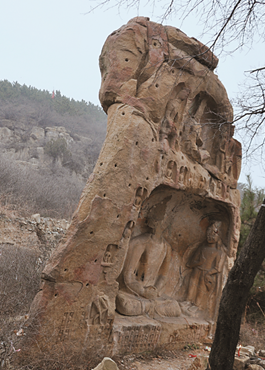
Rock Sculptures Of Kongwang Mountain.
Frequently Asked Questions
Frequently Asked Questions About the Rock Sculptures of Kongwang Mountain
1. What is the best time to visit the Rock Sculptures of Kongwang Mountain?
The Rock Sculptures of Kongwang Mountain can be visited year-round, as they are open 24/7. However, the best time to visit is during spring and autumn when the weather is mild and the surrounding scenery is particularly beautiful.
2. Is the site suitable for children and the elderly?
Yes, the Rock Sculptures are accessible to visitors of all ages. The paths leading to the sculptures are relatively gentle, making it suitable for children and the elderly. Just be mindful of individual mobility levels, as some areas may have uneven terrain.
3. How much time should I plan for my visit?
A visit to the Rock Sculptures typically takes about 20 to 30 minutes. However, if you wish to explore the surrounding Kongwang Mountain Scenic Area or take your time enjoying the views and taking photos, you might want to allocate 1 to 2 hours.
4. Are there English signs available at the site?
While the primary language is Chinese, there are some English signs and informational plaques available at the site. If you are unsure about something, feel free to ask local staff or fellow visitors for assistance.
5. Is there an admission fee to see the Rock Sculptures?
No, entry to the Rock Sculptures of Kongwang Mountain is free. This allows you to enjoy the rich history and cultural heritage without any cost.
6. What are the recommended nearby attractions?
After visiting the Rock Sculptures, consider exploring other nearby attractions such as Kongwang Mountain itself, Shipeng Mountain, Longdong Nunnery, and Longdong Scenic Area for a more comprehensive experience of the region’s natural beauty and cultural significance.
7. How do I get to the Rock Sculptures of Kongwang Mountain?
The Rock Sculptures are located in the Kongwang Mountain Scenic Area in Haizhou District, Lianyungang City. You can reach the site via public transport, taxi, or by driving. Local signage makes it easy to navigate once you are in the area.
8. Are there facilities available on-site, such as restrooms or food options?
Yes, there are basic facilities available near the Rock Sculptures, including restrooms. However, food options may be limited, so it’s a good idea to bring snacks or plan to dine in nearby areas after your visit.
Final Thoughts on Your Trip
As you conclude your exploration of the Rock Sculptures of Kongwang Mountain, take a moment to reflect on the rich tapestry of history and artistry that surrounds you. These ancient carvings, dating back to the late Eastern Han Dynasty, tell timeless tales of Buddhist and Taoist legends, captured in stone for over 1,800 years. Standing before the remarkable cliff faces, where over 100 figures express a myriad of emotions and narratives, you are not just witnessing art; you are engaging with a piece of cultural heritage that has withstood the test of time.
The breathtaking views from Kongwang Mountain serve as a beautiful backdrop to these carvings, enhancing the experience with nature’s majesty. As you explore further into the scenic area, consider how the intertwining of history, religion, and artistry creates a unique journey that resonates deeply with those who walk these paths.
Embrace the inspiration that comes from these ancient stones and let it guide your adventures ahead. Whether you’re an avid traveler or a curious explorer, the echoes of the past at Kongwang Mountain are sure to linger in your heart, inviting you to delve deeper into the wonders of our world. So go forth, and let the stories of Kongwang Mountain inspire your own journey, wherever it may lead you.